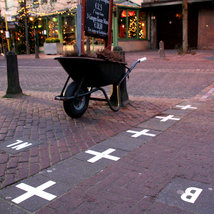Border: Belgium-Netherlands
Date(s) of establishment: 1843 - current demarcation 1995Length of border: 451 km
Regions concerned: Belgium: West Flanders, East Flanders, Antwerp, Belgian Limburg, Liège
Netherlands: Zeeland, North Brabant, Dutch Limburg
The Belgian-Dutch border is 450km long and separates the north of Belgium from the south of the Netherlands, in an east-west orientation. It begins in the east on the Vaalserberg, a hill situated close to Aachen in Germany and the tripoint between the Netherlands, Belgium and Germany (highest point of the Netherlands at 322 m) and ends in the west, close to the North Sea.
The border used to be indicated by 369 boundary markers, which were positioned in places where the border changed direction. Today, certain markings on the ground still demarcate the separation between the two countries.
History:
Belgium gained independence in 1830, but its border with the Netherlands was not established before the Treaty of London of 1839. The demarcation of the border was confirmed and ratified in 1843.
This border has several distinctive features, notably the enclaves around which the demarcation of the border proved very complex. The location of the town of Baarle was such that, when the border was being established in 1843, this portion was left out of the agreement. Today the town of Baarle is divided between the Netherlands and Belgium and therefore between two distinct municipalities: Baarle-Hertog on the Belgian side and Baarle-Nassau on the Dutch side. In 1959, The International Court of Justice attributed the majority of the contested parcels of territory to Belgium. Despite this, the border was officially established only in 1995.
Cross-border cooperation:
These two countries of modest size, located in an area of exchange, quickly realised that cross-border cooperation was an important lever for their mutual development. The first Interreg programme focussed on the region was thus implemented as early as 1990.
The Belgian-Dutch cross-border region is one of the most integrated and developed in Europe. The principal themes for action within the programme are linked to environmental issues, growth and the well-being of the population. Given the economic good health of the region, the priorities of the Belgium-Netherlands Interreg programme are essentially targeted at the elimination of institutional and administrative obstacles to cross-border cooperation.
The programme is concerned first of all with the creation of specific tools, with the public and private entities involved, allowing for a greater depth of cross-border cooperation and better adaptation to development and innovation. In this context, the sectors of research and development are strategic priorities.
The cooperation programme is also focussed on the environment: the cross-border territory is highly dense and industrial, necessitating considerable emergency planning and disaster prevention measures.
The two countries are also involved in the “Two Seas” Interreg programme that aims to create links with the United Kingdom and support Belgian-Dutch economic activity in the direction of Great Britain (and vice-versa). The program also seeks to improve access to the concerned areas and to encourage tourism in the region. It functions in close collaboration with the “France-England” Operational Programme.
Lastly, on the smaller scale of the two Dutch provinces (central Limburg and southern Limburg), the “Euregio Meuse-Rhine” operational programme further strengthens cooperation, with objectives primarily concerning energy and strengthening the job market.
The populations also play an important role in the development of cooperation, and all the more so given the common language they share. The “Scheldemond” Euroregion contributes to the reinforcement of identity and territorial unity, by proposing services to the population and joint cultural initiatives to the two countries.
Territory projects and institutional bodies for cooperation
Cross-border cooperation at the regional level
Eurorégion ScheldemondEuregio Meuse-Rhin
Réseau de Villes Maastricht-Aachen-Heerlen-Hasselt-Liège


